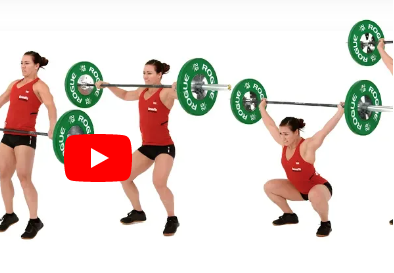The snatch is a weightlifting movement that involves lifting a barbell from the ground to an overhead position in one continuous motion. It is one of two competitive lifts in Olympic weightlifting, along with the clean and jerk.
To perform a snatch, a weightlifter starts in a squatting position with the barbell on the ground. The weightlifter then explosively pulls the barbell off the ground using their legs and hips, keeping their arms straight. As the barbell reaches its maximum height, the weightlifter pulls their body under the barbell and catches it in an overhead position with their arms fully extended. The weightlifter then stands up with the barbell overhead to complete the lift.
The snatch requires a combination of strength, power, speed, and technique. It is a complex movement that takes time and practice to master. Competitors are judged on the heaviest weight they can lift in three attempts, with the highest successful lift counting towards their total score. The snatch is often considered the more technically demanding of the two lifts, and it requires a high degree of coordination, balance, and flexibility.
Some key elements to perform the snatch include the grip, stance, and posture. The grip width can vary, but typically a wider grip is used to provide more leverage and control. The stance width should be about hip-width apart, with the toes pointed slightly outward. Maintaining a neutral spine and keeping the shoulders pulled back and down are also important for proper posture.
The snatch is often broken down into different phases, including the first pull, the transition, and the second pull. The first pull involves lifting the barbell off the ground using the legs and hips. The transition is the point at which the weightlifter pulls their body under the barbell and begins to catch it in an overhead position. The second pull involves the weightlifter explosively extending their hips and driving the barbell upward to complete the lift.
Training for the snatch involves developing strength, power, and technique through a variety of exercises, including squats, deadlifts, and pulling movements. It is important to have a qualified coach to guide you through the learning process and to ensure proper form and safety.
The snatch is a highly technical and impressive lift that requires a lot of skill and dedication to master. It is a key component of Olympic weightlifting and is also used as a training tool for athletes in other sports, such as football and track and field.
There are several benefits of incorporating the snatch into your training program. The snatch is a full-body exercise that targets multiple muscle groups, including the legs, back, shoulders, and arms. It also requires a high degree of explosiveness and power, making it an effective tool for developing speed and agility.
In addition, the snatch can help improve mobility and flexibility in the hips, shoulders, and wrists. It requires a full range of motion in these joints, which can help prevent injuries and improve overall athletic performance.
Like any exercise, it is important to approach the snatch with caution and gradually build up weight and intensity over time. Proper technique and form are critical for avoiding injury and getting the most out of the exercise.
Overall, the snatch is a challenging and rewarding lift that can help improve strength, power, and athletic performance. With the guidance of a qualified coach and a commitment to consistent training, anyone can learn to perform the snatch and enjoy its many benefits.
It is worth noting that the snatch is not just a competition lift, but it can also be used as a training tool to improve other lifts and movements. For example, the explosiveness and power developed during the snatch can carry over to other explosive lifts like the clean and jerk, as well as sports like basketball, football, and track and field.
In addition, the snatch can be used as a variation of the traditional deadlift or squat to challenge the body in new ways and break through plateaus. Adding snatch variations to your training program can help increase overall strength and power, as well as improve technique and mobility.
It is also important to recognize that the snatch is not for everyone. Some individuals may have limitations or restrictions that prevent them from performing the lift safely and effectively. In these cases, modifications or alternative exercises may be necessary.
In summary, the snatch is a highly technical and challenging lift that can provide numerous benefits for those who are able to perform it safely and effectively. With the proper guidance and training, anyone can learn to perform the snatch and incorporate it into their training program for improved strength, power, and athleticism.
![]()
